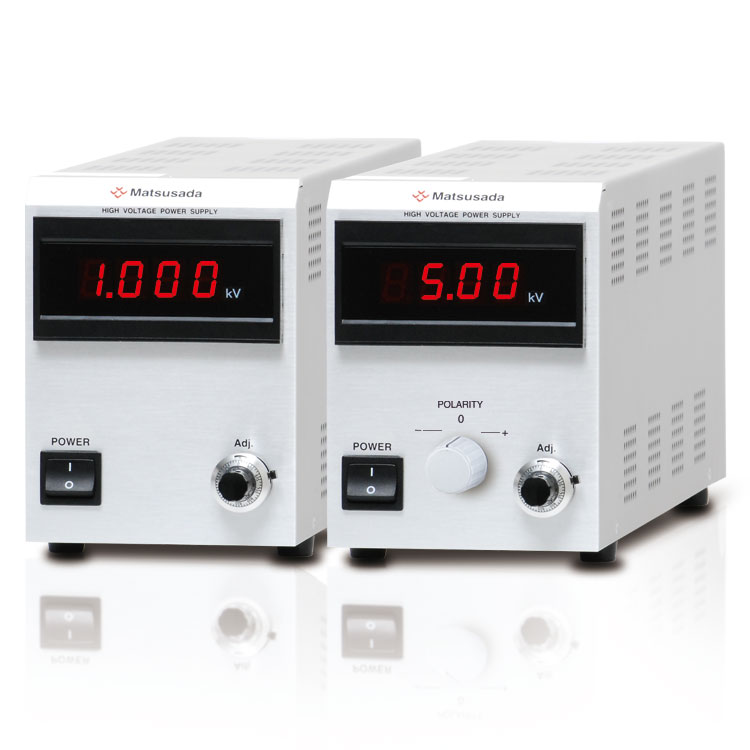
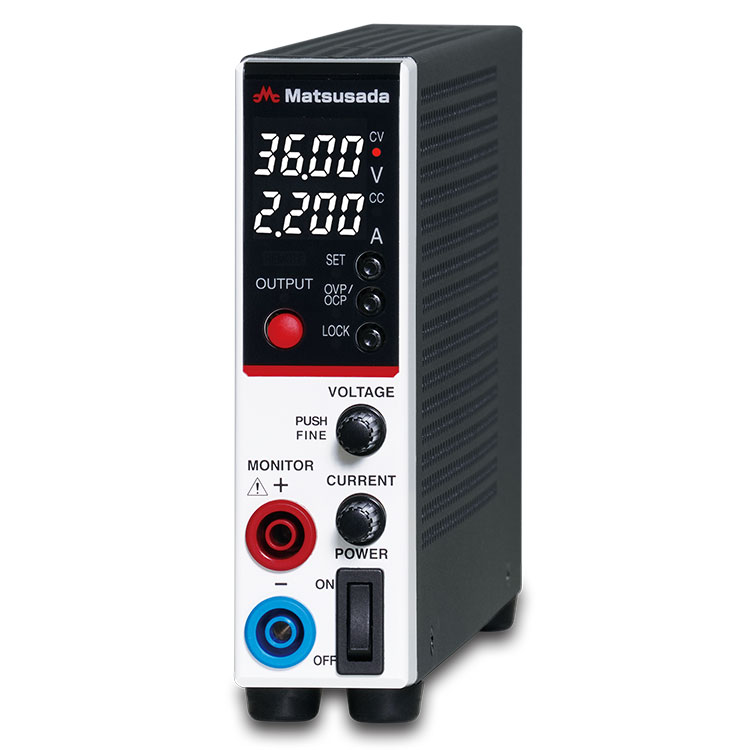
A DC power supply is a device that generates and supplies a steady direct current (DC) from an AC outlet. It is used as a power source to run electronic circuits or test electronic devices.
For example, household electrical outlets in Vietnam are supplied with 220V AC voltage, but in reality there are small voltage fluctuations due to losses during the power supply process and changes in power consumption of devices connected to the same power source.
Voltage fluctuations that supply relatively simple household appliances, such as vacuum cleaners and fans, do not cause many problems. However, for precision devices such as electronic equipment, even a small change in voltage can cause malfunction.
Also, since DC power is required to run electronic devices, the supplied AC power has to be converted to DC power. A stabilized DC power supply is used for this purpose.
DC power supplies can be divided into two types depending on the output method: constant voltage power supplies and constant current power supplies. In constant voltage power supplies, the output voltage is controlled so that it remains constant even when the power supply load changes. On the other hand, constant current power supplies are controlled so that the output current remains constant.
When selecting a DC stabilized power supply, there are two main points to consider: output range and circuit method.
The output range of a DC regulated power supply varies greatly depending on whether it is a single range or wide range system.
A single-range power supply is a power supply in which the combination of voltage and current that can be produced is determined by the rated voltage and rated current. For a stabilized DC power supply with a rated voltage of 80V and a rated current of 10A (PK80-10 (800W)), the maximum output voltage is 80V, the maximum output current is 10A, and the maximum power consumption is 800W.
On the other hand, a wide-ranging (variable) power source is one in which the combination of voltage and current that can be produced is determined by the power consumption in addition to the rated voltage and current.
In the case of a regulated power supply (PKT80-50 (800W)) with a rated voltage of 80V, a rated current of 50A, and a power consumption of 800W, the current that can be output at a maximum output voltage of 80V is limited to 10A, which means the power consumption is below 800W. Similarly, the voltage that can be output at a maximum output current of 50A is limited to 16V, and the combination of maximum output voltage and maximum output current cannot be used as in a single-band system.
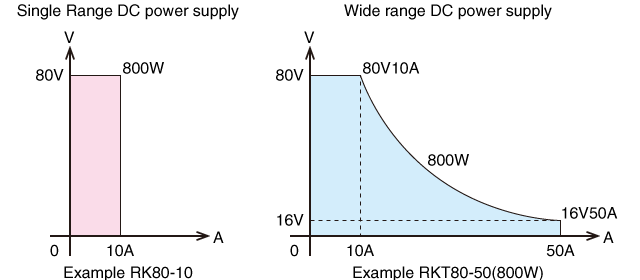
If you choose the same power consumption, a single power supply will be less expensive. If you always perform tests with fixed current and voltage, it is better to choose a single range power supply.
However, when testing electronic devices that only require high currents at start-up, such as motors or battery-powered electronics that drop in output voltage as they run down, many different combinations of voltage and current are needed. Therefore, if you try to use a single-strip power supply, you will need a lot of power supplies.
In addition, if you prepare a single power supply with such a wide range, the cost will increase and the size of the power supply will also increase. In such cases, a wide range power supply can be selected to save both cost and space. There are two types of wide range power supplies: wide output range and narrow output range. The model shown in the example above has a wide range output capability of 5 times. When choosing a wide power supply, be sure to check the width of the range.
method, series regulation method, linear regulation method, series trickle method, etc. The input alternating current (AC) is converted into direct current (DC), then the voltage and current are controlled by a transformer and sent out. On the other hand, the switching method converts the current converted into DC into high-frequency AC power by using coils or semiconductors, and then converts it back into DC to control the voltage and current.
In the past, DC power supplies were common. However, in recent years, the need for wide-range (variable) DC power supplies has increased due to the increasing use of battery-powered devices and a wider variety of electronic devices.
There are two types of circuits for regulated DC power supplies: dropper and switching circuits.
The trickle method is also known as the series method, linear method, series regulation method, linear regulation method, series trickle method, etc. The input alternating current (AC) is converted into direct current (DC), and then the voltage and current are controlled by a transformer and sent out. On the other hand, the switching method converts the current converted into DC into a high-frequency AC source using a coil or semiconductor, and then converts it back into DC to control the voltage and current.
The disadvantage of the switching DC regulated power supply is that its mechanism generates a small amount of noise. Therefore, it is not suitable for equipment that is susceptible to noise. On the other hand, the trickle method has the advantage of low noise and high responsiveness to load changes. However, they also have the disadvantage of being large, heavy, and generating a lot of heat.
A typical desktop computer also comes with a built-in switching DC power supply, but if you want to use a trickle system, you'll need a power supply the size of a toaster. For this reason, switching DC power supplies have become the norm in recent years.
When selecting a DC power supply, first determine the output range by examining the voltage and current required to operate, then examine the effects of noise, response, and device operability, and select the best type for your application.
As wide-range power supplies have been widely used in recent years, the performance and functionality of DC regulated power supplies are increasingly improved.
Therefore, even if there is no specific problem with the DC stabilizer power supply you are currently using, you should still consider purchasing a new power supply if any of the following points apply.
The problems of size, weight, efficiency and heat generation can be solved by changing the trickle type power supply to the switching type. In addition, in recent years, the user interface has been greatly improved with meters and remote controls, making it easier for people to use the power supply. Therefore, if you feel that your power supply is getting old, you may want to choose a new one.
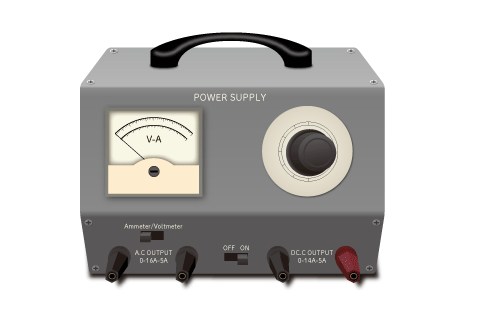
Old DC power supply
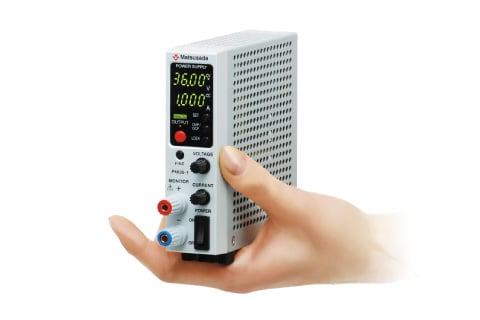
The latest DC power supplies are
So what should we pay attention to when using DC regulated power supply? Basically, regardless of whether the DC regulated power supply is a trickle type or a switching type, it is important to ensure heat dissipation when using it. Using the power supply in a dusty place can also reduce its service life.
Also, check each point for problems when using the product, depending on the situation.
If the device does not start properly the first time it is powered up, the overcurrent protection function may be activated. In this case, review the current setting of the DC power supply. It is best to check the current of the power supply again, taking into account the inrush current when starting the load side.
If the input circuit breaker is tripped or the external fuse is blown, the inrush current may have affected the system. Generally, the inrush current of a regulated DC power supply will be several times to several dozen times higher than the normal current when energized. Check the inrush current of each regulated DC power supply as well as the specifications of the circuit breaker and fuse.
If the problem persists after checking, contact the manufacturer's support department. DC power supplies and other power-related devices can cause serious problems if they fail, causing other devices to not work. It is best to choose products from manufacturers with quick responses and detailed support.
DC power supply of Matsusada Precision is a high-efficiency regulated DC power supply (DC power supply)/bidirectional power supply (regenerative power supply) that pursues “compactness”, “low noise” and “high power.
SEMIKI There are a wide range of products, from palm-sized precision DC power supplies to desktop sizes and high-power Rackmount/Cabinet types.